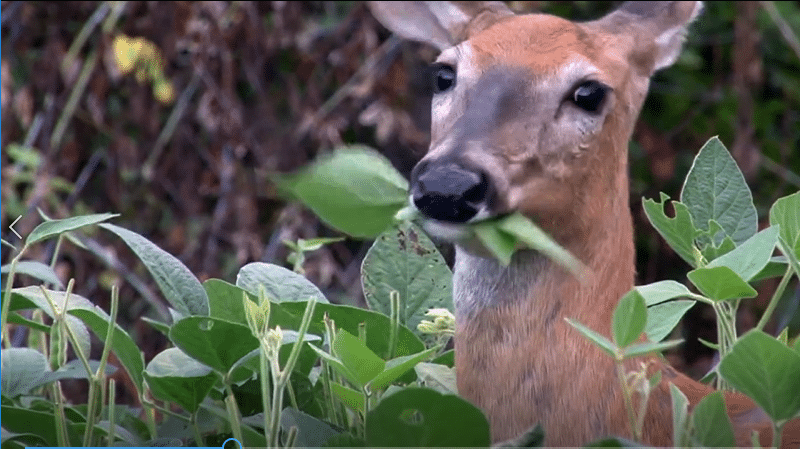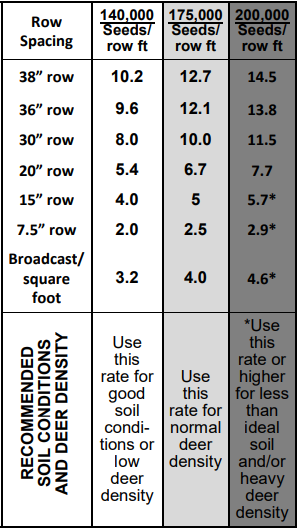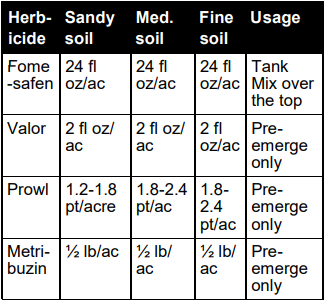RR Forage Soybeans
Glyphosate Tolerant Soybean Planting Guide

Fertilizer
The optimum pH for soybeans is between 6.0 and 7.0. Ideal pH is 6.5.
- Inoculate soybeans with Bradyrhizobium japonicum if the site has been waterlogged, extremely cold, or has no recent soybean production. Inoculant can also reduce your fertilizer costs. Nitrogen is not needed on decent soil if the soybeans are inoculated. Starter N is fine. We recommend inoculant be applied to the seed just prior to planting. Add the inoculant to the seed hopper and stir gently, do not add moisture (check with inoculant label).
- For best results, lime and fertilize according to your farm’s soil test. If you don’t have a soil test, use inoculant and 0-40-70 (units) per acre. Soybeans remove a minimum of 40 lbs. of Phosphorous and 70 lbs. of Potassium per acre per year. For maximum deer antler and body weight, use 0-70-120.
- Always use fresh seed; store seed in a dry, low humidity environment below 85°F.
Inter-seeding with Roundup Ready Corn
To maximize plant growth for both species, it is best to plant soybean and corn in separate patches. If you prefer inter-seeding them, studies show that optimum results are achieved with 3-5 lbs. corn and one bag per acre of soybeans. Add N for the corn, soybeans will fix only enough for their own use.
Herbicide Application
- It is best to start with a clean, weed-free seed bed. Use tillage or a pre-plant burndown herbicide such as Roundup (glyphosate only version) or Liberty depending on your emerged weeds and use a pre-emerge herbicide. Make sure your pre-emerge herbicide is activated by rain or irrigation. You can use Valor, Metribuzin, or Prowl at the labeled rate (make sure to read and follow label directions).
- Roundup PowerMax and WeatherMax (rate is 22-32 fluid oz/acre) are the best products. BE CAREFUL NOT TO USE GENERIC OR ROUNDUP FORMULATIONS WITH ADDITIONAL ACTIVE INGREDIENTS! THE ONLY ACTIVE INGREDIENT IN GENERIC OR ACTUAL ROUNDUP SHOULD BE GLYPHOSATE. Generic glyphosate, (rate is 32-40
fluid oz/acre) labeled for soybean, can be applied to the crop at any time. The key to weed control is to eliminate weeds in the first 3 to 4 weeks. It is important to spray weeds BEFORE they reach 4 inches in height or they will reduce your yield and use up your water and fertilizer. You can add or tankmix Fomesafen over the top at the labeled rate for increased pigweed or waterhemp control (make sure to read and follow label directions).
Planting Time, Depth, Spacings (see top chart)
- In general, most northern food plotters can plant in late May or early June. Southern food plots can usually be planted in late April to early May. Check with your local extension service for optimum dates. This is usually after your last spring frost when the soil temperature at a one inch planting depth is above 65°F, but no greater than 90°F. Soybeans have a different kind of emergence, so it is usually best to plant after a rain. Rain can cause surface soil compaction and crusting which prevents plant establishment.
- The recommended planting depth is 3/4 to 1 inch into a moist soil. Do not plant in a dry soil, or in muddy conditions. Plant a minimum of one bag per acre 1/4 inch below soil moisture line, but no deeper than 1.5 inches. If you do not see emergence in 7 days, check the seeds for sprouting. When broadcasting, increase your seeding rate up to 75 lbs per acre since not every seed will have proper seed to soil contact.
Establishment
Plants grow slower in cooler spring temperatures, so use deer deterrents for the first 4-8 weeks, especially in areas of heavy deer pressure. Electric fences are the best deterrents. Many customers also find Milorganite is useful when spread at 75 lbs/ acre.
Drainage
Soybean plants can die when water stands on an area for 3 or more days. Make sure your crops have good drainage. Avoid flood prone areas.
*Data compiled from U of A MP 44. Check with your state extension and always follow pesticide labels


